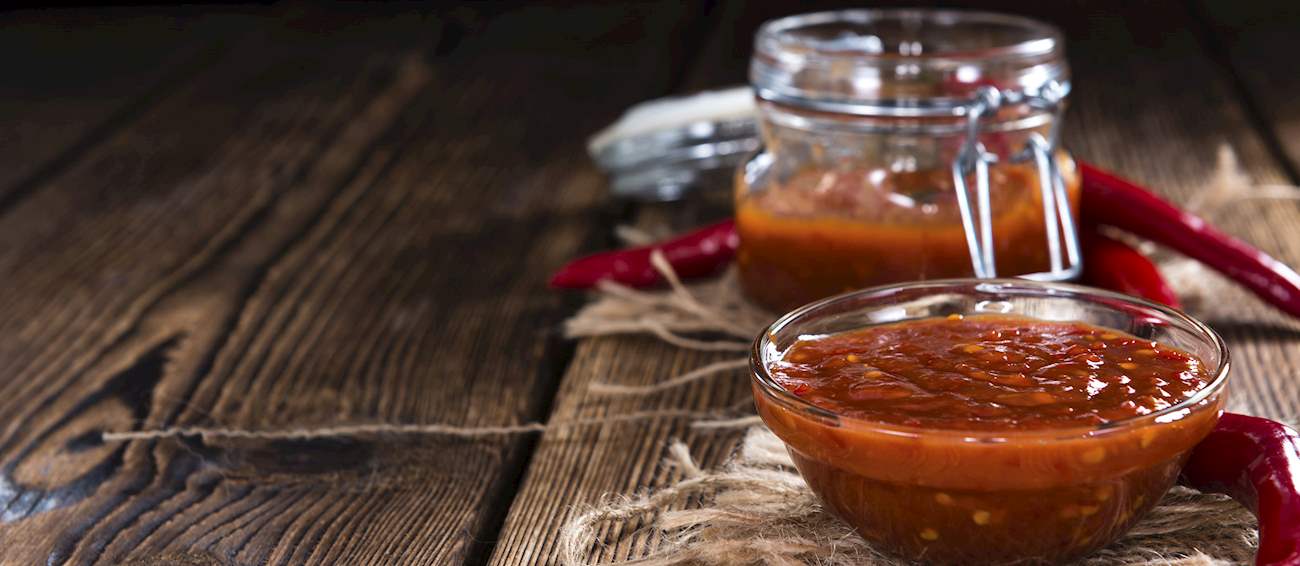Sambal
(Sambal Olek, Sambal belacan)
This quintessential Southeast Asian condiment is usually made only with spicy chili peppers and salt. It is occasionally adapted with lime juice, onions, sugar, ginger, shrimp paste, or vinegar. Traditionally prepared in a mortar, it is characterized by its thick consistency and an incredibly strong and sharp flavor.
This original Indonesian creation has gained worldwide acclaim, and store bought varieties are available at numerous Asian food markets and international stores around the world. Sambal is used in a variety of Asian dishes, usually as a spicy condiment, seasoning, or a topping served alongside meat, seafood, vegetables, or rice.
Types of Sambal
Part of
Masak lemak
Masak lemak is a vibrant yellow Malaysian curry with a supposed origin in Negeri Sembilan. The dish can be prepared with various proteins such as chicken (ayam), fish ... Read more
Tinutuan
Tinutuan is Indonesian rice porridge that originated in North Sulawesi in the city of Manado, but it's also often associated with Minahasa. The most common vegetables ... Read more
Bihun sup
Bihun sup is a traditional noodle soup originating from Malaysia. The dish consists of beef broth, rice vermicelli noodles, and sambal chili paste. The broth is usually ... Read more
Sambal kangkong
Sambal kangkong is a traditional vegetable dish originating from Malaysia. The dish is usually made with a combination of water spinach (kangkong) and sambal chili paste ... Read more
Serve with
Laksa
Characterized by its rich and spicy broth, this comforting noodle soup is one of the classic dishes found in many Southeast Asian countries. It was developed under the ... Read more
Recipe variations
Basic Sambal Ulek
READY IN 5minAlso known as sambal oelek, this simple sambal is often used as a base for making other sambal varieties, or as a condiment on its own. Fresh chili peppers with seeds and some salt are simply ground by hand or pureed in a food processor until the desired texture is reached.
Sambal Terasi
READY IN 10minSambal terasi is a type of sambal that can be prepared with fresh or sautéed ingredients and has numerous regional varieties. Because of its sweetness, it is considered to be the best option for sambal beginners. The main ingredient, apart from chilies, is the shrimp paste called terasi which gives this sambal a distinctive taste. However, to make it according to tradition, you will also need to add citrus (lemon or lime) juice.
Sambal Bajak
READY IN 25minSambal bajak, also known as sambal badjak, is very popular on the island of Java. The following recipe suggests roasting the ingredients in the oven, grinding them, and then sautéing the sambal once again in a wok. What distinguishes this type of sambal from others is the use of candlenuts, tomatoes, garlic, coconut sugar, and terasi dried shrimp.
Sambal Kecap
READY IN 5minThe following is the recipe for sambal kecap, a type of sambal made with soy sauce and chopped vegetables. It looks more like a salad than a sauce and is commonly served with barbecue dishes.
Sambal Authentic recipe
Also known as sambal oelek, this simple sambal is often used as a base for making other sambal varieties, or as a condiment on its own. Fresh chili peppers with seeds and some salt are simply ground by hand or pureed in a food processor until the desired texture is reached.




















